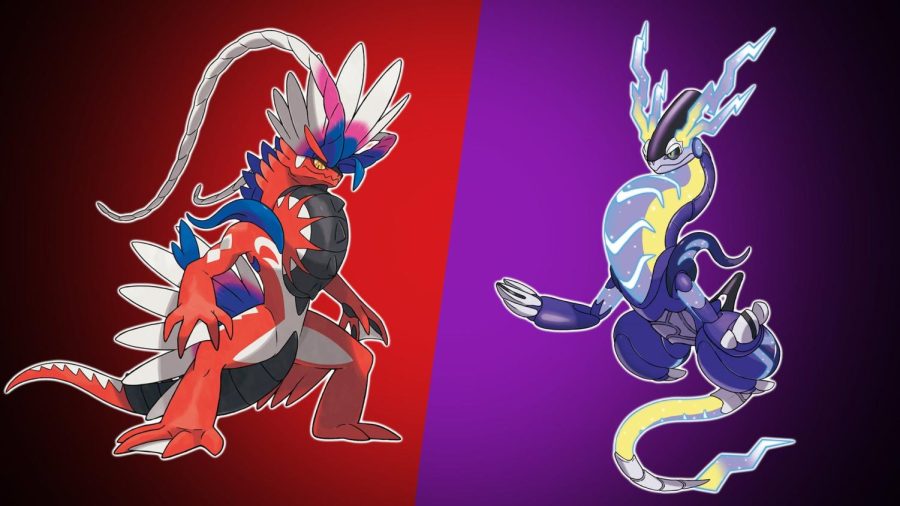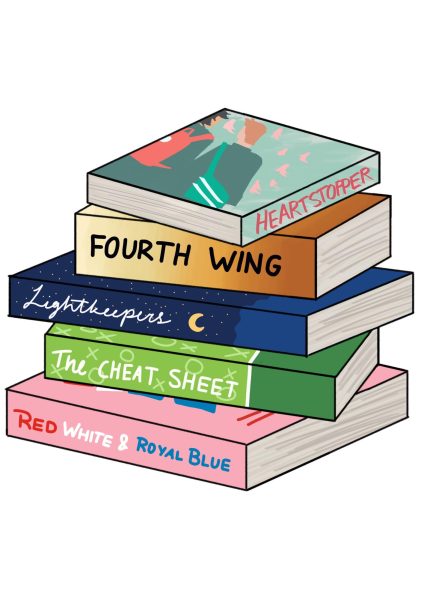Pokémon “Scarlet” and “Violet” review
Pokémon “Scarlet” and “Violet” are the most recent additions to the Pokémon game franchise. Their releases had been highly anticipated for months; players were excited about features such as auto-battling and free exploration. Pokémon even redesigned all of the previous Pokémon models! Many of the new Pokémon designs are charming, with humorous names. The starting Pokémon are no exception: Spirigatito, a mystical grass-type kitten, Quaxly an insecure water-type duckling, and Fuecoco, a ravenous fire-type bipedal crocodilian. However, interest in the games fell off shortly after their release. Opinions on the games have become a hot topic throughout the gaming community, with the games receiving a whopping 2.7 out of five on Google at the time of publishing. It was accompanied with many issues, receiving harsh but justified backlash from players and critics alike.
The majority of the criticism is due to the games’ laggy gameplay and seemingly unfinished features. Players have encountered game-breaking bugs and glitches that not only turn players away, but can even cause, in some cases, irreparable damage to a game file or save. While these issues may not affect everyone to the same extent, it is still unreasonable for any game to be released in such a state, disappointing both life-long fans and new players.
Numerous issues are found in the graphics, with some people experiencing an extremely poor framerate. This is an issue because, as many people have mentioned, Nintendo is a AAA company — a company with a high budget and profile — and argued that because of their value, the quality of production should be much higher.
“No matter how much you like Pokémon, I think it’s in an inexcusable state for 60 dollars,” said popular Twitch streamer MoistCr1TiKaL.
His take is reflected widely within the community, following the disappointment of many players. Many complaints are also about the features that were excluded from previous games. For example, the indication of overworld shinies being present was removed, which makes shiny Pokémon much more difficult to find. Most players are not greatly affected by this; to them, it is nothing but a minor inconvenience. However, this poses a larger issue to color blind players, as these rare Pokémon typically have differences of a couple shades distinguishing them from their regular counterparts. In previous games, there was some sort of indication that either the Pokémon encountered, or a Pokémon nearby was shiny. As of now, there is no feature to let the player know that there is a shiny unless you recognize or run into it, making a part of the experience much more difficult for some of the community.
Another downside of the new gameplay is the lack of level scaling in the stories. This means that all of the storyline bosses and challenges have a set level, instead of changing to better fit your current skills. This prevents most players from being able to take out some gyms right off the bat, despite the stories being completely open world. While this pushes players in a theoretical order, it also opens the door for more challenging battles. Also, “set” style, the option to force the player to play with the Pokémon currently on the field before having the option to switch out, was removed, eliminating an opportunity for players to challenge themselves.
Despite the issues with the new and old features in the franchise, “Pokémon: Scarlet” and “Violet” add a lot to the mechanics and introduce a grand total of 103 new Pokémon — the largest number of Pokémon released in one game since 2010. This large addition comes hand in hand with the large map of Paldea — the region in which the games take place — with it being completely free to explore to your heart’s desire. Running into many evolved Pokémon and Pokémon in groups adds a new level of immersion to the experience. Many new features were added in accordance with an open world, such as optional trainer battles and even a feature for auto battling. Despite the lack of a clear indication of a shiny, overworld shinies, a well liked feature that originated in “Pokémon: Let’s Go Eevee” and “Pikachu,” were brought back. A big open map and lots of Pokémon make the new auto-battling feature and the exploration side of things considerably more enjoyable, putting an effective end to the repetitive grinding for levels. Just running around exploring the new map and finding the new Pokémon is a blast, which is something that is not an option in all Pokémon games.
Recent Pokémon games have each had their own unique gimmick: “Pokémon: X” and “Y” with mega evolutions and “Pokémon: Sword” and “Shield” with “Gigamax” forms. Scarlet and Violet are no exceptions, presenting a new mechanic to players: terastallization. This mechanic assigns a “tera form” to each Pokémon, and when it “terastallizes,” it changes its type to that of its tera form. This allows for new combat strategies, where switching the type of a Pokémon could pull you out of tough situations. You can only terastallize once per battle, using up the charge of your “tera orb,” which is only rechargeable at a Pokécenter when you heal your Pokémon. With the addition of terastallization, Scarlet and Violet have Pokémon who spawn in the wild that can terastallize when encountered. These wild terastallized Pokémon can also be fought within raids, where you and either a team of bots or friends of yours battle together to take it down. Once defeated, you are given the option to catch or release it, and if caught, the Pokémon keeps the tera form that was present when it was fought.
As mentioned previously, the option to battle with your friends in the new Pokémon games is there. While this is not a new feature, additions to multiplayer things have been introduced. Scarlet and Violet both have a mechanic that allows people whom you invite to play on your map, and explore Paldea together. This is an entirely new feature to Pokémon as a whole, and it allows players to experience a completely new way to play their game. However, this feature is prone to glitching — much more than playing in single-player is. Being a brand new feature, it is likely experimental seeing as it does not run smoothly at all.
Bugs aside, “Scarlet” and “Violet” are some of the most enjoyable mainline Pokémon games ever released. With many Pokémon games aging relatively poorly in comparison to some of the newer titles, these games bring a new era of hope — a big step forward, an improvement over “Pokémon: Sword and Shield.” The refreshing storyline and new gameplay is exciting, and it is beginning to look like a new era for Pokémon.














